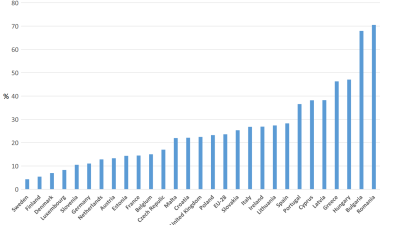by Stephen Crossley and John Veit-Wilson
On Monday 21st of January, in response to a question about the government’s commitment to reducing child poverty, the Secretary of State for Work and Pension talked of a:
‘full public consultation about a better way to measure real child poverty that the coalition Government will set and measure ourselves against. Income will be part of it, but not the dominant part ...’ (Hansard, vol. 557, no. 100, p73)
Ian Duncan Smith was referring to the consultation document on ‘Measuring Child Poverty’. Published in November 2012 this launched a consultation process that is not due to be completed until 15 February. Yet the exchange in the House of Commons gives every impression that the Government has already made up its mind. If so, the consultation process seems little more than a sham.
The consultation, which is keen to ‘reflect public opinion’, presents a very real opportunity to build on the consensual methods work being carried out by the PSE Team and the work on Minimum Income Standards that JRF funds which has already given life to strong Living Wage campaigns across the UK. It is a perfect opportunity to discuss how to capture the reality of poor quality, insecure, low paid work and the ‘relentless rise of in-work poverty’, as Chris Goulden has called it. In seeking ‘a better representation of the reality of children’s lives’ it also presents an excellent opportunity to include the voices of children and young people in this debate, as organisations such as CPAG and Children North East have done recently.
However, any attempt to view the consultation in a positive light will have been immediately tested by the publication of the consultation document. No (new) definition of child poverty was presented, despite the ‘need to think differently’ about it. Potential dimensions were often illustrated with quotes highlighting the perceived behavioural shortcomings of people living in poverty (e.g. “You want to get your parents down the job centre!” p25, “It’s living in estates. They breed poverty…”, p32) and they appeared to overwhelmingly confuse a measure of poverty with potential causes and/or conditions. This, it seems, is like trying to count the number of cases of flu in terms of counting all those with headaches, muscle pains, runny noses etc instead of those with or without the flu virus in them. (See the PSE response and that of Professor Paul Spicker for more detailed criticisms of the proposed dimensions).
Worse than this, it now seems that Iain Duncan Smith is pre-empting the input from respondents. The process thus represents a form of ‘pseudo-consultation`, one very far away from the tradition based on the old green paper approach to government consultation on policy options (see for example the Tax Credit Green Paper, Cmnd 5116, 1972). That may be in part because, as Professor Bradshaw points out in the PSE response, it does not appear to have been written by anyone with any academic grounding either in the procedural methods or substantive findings of social science in this field. It does, however, appear to have been written by someone who has read this Policy Exchange report on ‘Tackling the causes of poverty’ from 2011, which, in turn built upon this Policy Exchange report from 2009 on ‘Poverty of ambition’ and also drew on work from a previous DWP consultation in 2002. That consultation was also concerned with finding ‘better’ measures of child poverty and was also methodologically flawed in confusing measures, causes and conditions. So Iain Duncan Smith’s method is hardly new.
Instead, the current consultation appears reminiscent of a market advertising approach taken by manufacturers who have a new or revived product they wish to re/launch on the market. Their problem is testing which kind of message will work best for the advertising to persuade the customers to buy the product. They submit a range of 'messages' to the public to test which has the best response resonance, messages which can then be used in the design of advertising and packaging. One might conclude that what we are seeing is a consultation to sell a product which has already been decided on and where production has already started, a process apparently advised by people whose grounding is business and not social science. How far departmental officials experienced in policy and research on this topic have been involved in what might be seen as a propaganda exercise is completely unclear.
What is apparent is that the outcome from the consultation for a ‘better’ measure of child poverty will be one that conveniently fits with the policies already being pursued or advocated by the Coalition government. After all, if you can change how a problem is defined, you can justifiably change how you respond to it and, if you’re really clever, you may even be able to change the size of it.
Moreover, none of this is necessary. Drawing strength from a recent article by Ruth Levitas, it should have been possible to approach the current consultation on ‘better measures’ of child poverty with a ‘hermeneutics of faith’ and participate in an ‘attempt to restore meaning’ to the narrative around measuring child poverty. There is compelling evidence that multi-dimensional measures of poverty can and do work. A genuine public consultation would present the opportunity to address Peter Townsend’s concerns about definitions of poverty. Townsend wrote that ‘part of my purpose in writing Poverty in the United Kingdom was to call attention to the elitist and subjugatory ways in which the concept has been, and is, defined and applied’ and that ‘like other concepts, poverty can be given different meanings by professions, governments and bureaucracies’. As he suggested:
One of the tasks of the social scientist is to bring out how concepts tend to be the creatures of the arbitrary exercise of power; and to look beyond them to a more democratic representation of interests in the meanings they are given. (Townsend, P. 1993).
Steve Crossley is Regional Child Poverty Co-ordinator at Durham University. John Veit-Wilson is Emeritus Professor of Social Policy of Northumbria University and Visiting Professor in Sociology at Newcastle University
References
Townsend, P. (1993) ‘Theoretical disputes about poverty’, Chapter 6 from Townsend, P. The international analysis of poverty, Hemel Hempstead: Harvester Wheatsheaf



 PSE:UK is a major collaboration between the University of Bristol, Heriot-Watt University, The Open University, Queen's University Belfast, University of Glasgow and the University of York working with the National Centre for Social Research and the Northern Ireland Statistics and Research Agency. ESRC Grant RES-060-25-0052.
PSE:UK is a major collaboration between the University of Bristol, Heriot-Watt University, The Open University, Queen's University Belfast, University of Glasgow and the University of York working with the National Centre for Social Research and the Northern Ireland Statistics and Research Agency. ESRC Grant RES-060-25-0052.






